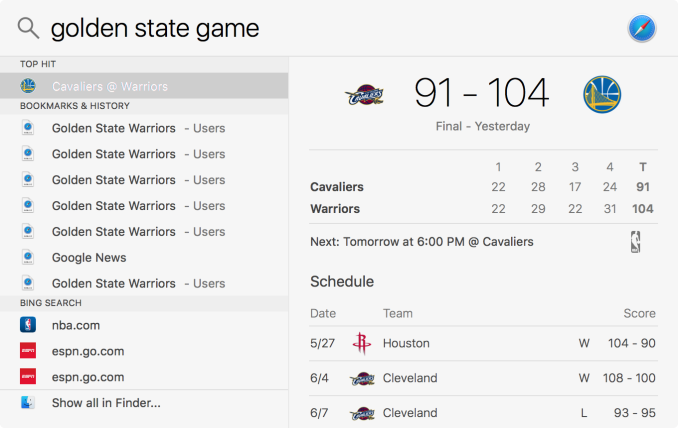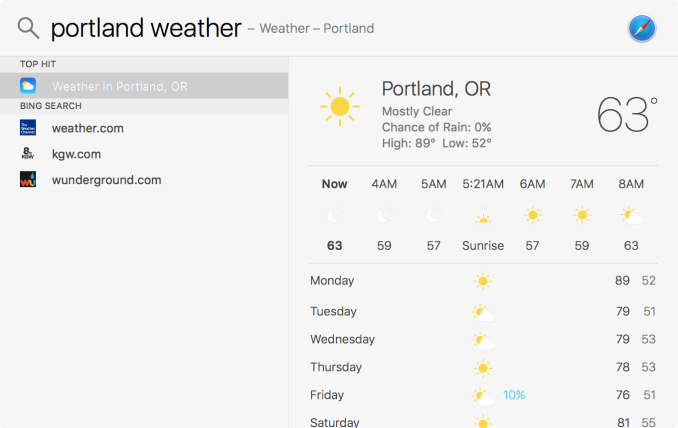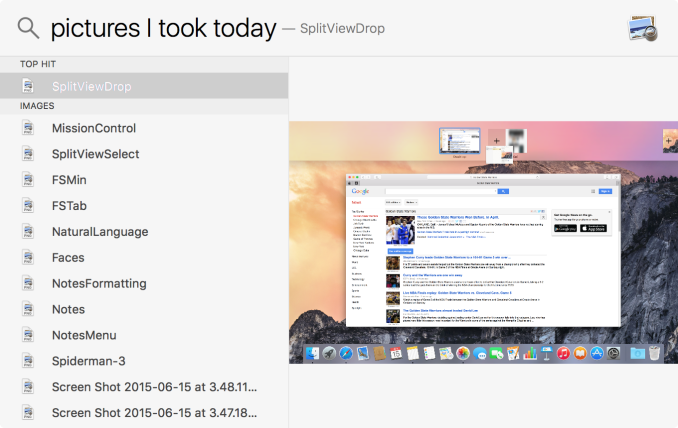A First Look At Apple's OS X El Capitan
by Ryan Smith on June 15, 2015 3:00 PM EST- Posted in
- Apple
- Mac
- Operating Systems
- macOS
Spotlight Gets Smarter: More Web & Natural Language Search
In Yosemite, Apple introduced the modern version of Spotlight, their combined local & web search tool. Replacing the previous drop-down iteration that was focused on local results, the rebuilt Spotlight became a pop-over window – practically a miniature application of its own – featuring not only improved local searching, but the ability to search and preview web sources as well.
For El Capitan, Apple is taking this a couple of steps further by giving Spotlight the ability to not just do keyword searches, but to better understand the context of searches and return results within Spotlight itself. Though Apple is not being overt about it, in a lot of ways the latest rendition of Spotlight is becoming increasingly Siri-like, as it gains a lot of Siri’s abilities to present data, and not just find it as was the case with Yosemite Spotlight.
On web side of matters – and by far the most Siri-like addition – Spotlight can now return and display results directly for the weather, stocks, sports, web videos, and integrate with Safari and Maps to include some of their search functionality as well. As it stands Spotlight can still only do a fraction of what Siri does, mostly due to the fact that it lacks Siri’s deep server-side analytic capabilities, but at the end of the day it’s in many ways a pared-down version of Siri for local use, capable of directly displaying results for some very common types of queries.
The single biggest difference here is really that Spotlight is just for searching, so it lacks any kind of command functionality. However I suspect that may be just a matter of time, especially as Microsoft is integrating their competing Cortana agent into Windows 10.
Moving on, the other major addition to Spotlight is the ability to understand natural language queries. Just as was the case in the OS’s included Mail application, Spotlight overall can execute natural language searches over documents, or over any application it is allowed to search in (e.g. Mail). As with Mail, the idea here is to make it easier to create queries, especially complex queries or queries for first time users, though all of the existing methods of searching remain unchanged.
As it stands I’m finding natural language searching a bit hit & miss. Some queries it handles well, while others it essentially fails to understand the query and falls back to web results. I suspect there’s a trick to this I haven’t quite picked up on when it comes to figuring out just what Spotlight can understand. Still, this is also a beta release and Spotlight is one of the few areas I’ve had issues with (requiring a system reboot at one point), so it may just be a case of needing to shake out the bugs.




















100 Comments
View All Comments
robcov33 - Monday, June 15, 2015 - link
Why waste space with any apple product?V900 - Monday, June 15, 2015 - link
Cause they're by far the biggest manufacturer of premium laptops, tablets and smartphones?Apple got around 90% of the +600$ smartphone market and over 80% of the +1000$ computer market.
That means that they're a huge part of the industry, and even the people who exclusively use 500$ HP laptops, such as perhaps yourself, are affected by their products and decisions.
jimmy$mitty - Tuesday, June 16, 2015 - link
That is vastly wrong. Apple has, of all the PCs sold, 13% market share roughly. They do not have 80% of the $1000+ laptop market as there are more options available from PC than there are from Apple.And Apple doesn't do anything for design nor are PCs run by their decisions. If they were we would all be using Firewire instead of USB. Half the time their products are behind the PCs in the latest technology.
NEDM64 - Wednesday, June 17, 2015 - link
You use USB because Apple pushed hard that standard with the original iMac.FireWire? FireWire is an IEEE standard.
And speaking about IEEE standards, Apple was on the first to push WiFi as a standard, with their consumer AirPort base stations, and AirPort interface cards, that came standard in most models, and turned 802.11 in a standard.
Just because you are not a professional, doesn't mean that other people don't use professional standards...
For example, the relatively cheap, FireWire connected, iSight camera was a staple in computer vision applications in mid-2000s, because it was cheap, and had much less lag, much better frame rate, much better, uncompressed image than any USB camera
Oxford Guy - Wednesday, June 17, 2015 - link
Firewire was a lot better than USB, except with Windows XP thanks to Microsoft's purposefully bad driver.And, had Apple not chosen to start using Intel hardware, Firewire would be really fast today. There are a bunch of faster versions that were in planning and development.
masouth - Tuesday, June 16, 2015 - link
While I agree that it needs to be covered, your reasoning is a bit specious.1) the smart phone market share doesn't mean anything at all when talking about OSX and mentioning it is just a red herring.
2) Simply being dominant in a certain market doesn't necessarily make you a HUGE part of an industry. Apple is certainly an important part of the market and they are a dominant force in the $1000+ market but have you ever looked at what their overall share of the PC market is? 15% in the US? Half of that world wide. Apple's total market share is smaller than the INDIVIDUAL market share of several of the WinPC vendors (HP, DELL, Lenovo, etc).
This needed to be covered simply because it is an update to the largest retail OS not named Windows and Apple is a media juggernaut that would get covered even if they started making toilet seats. Please don't try to delude people into believing that it has anything to do with iPhones or how few PC's Apple can push over a certain arbitrary price point.
serndipity - Tuesday, June 16, 2015 - link
Based on 2014 PC shipments, according to both IDC or Garnter, Apple's market share is 6% (up by 1% from 10 years ago).Additionally, from Consumer Reports 2015 buying guide, of the 25 computers rated, the best Apple best only placed 9th out of the 25, which was significantly, overall 20 points lower than their top pick (i.e. Dell).
Based on Apple's 2015 hardware and software offerings, it appears that their market share will fall back into the 4 - 5% of range.
Oxford Guy - Wednesday, June 17, 2015 - link
Consumer Reports' recommendations range from fairly informed to highly flawed.Bansaku - Friday, June 19, 2015 - link
Numbers are skewed, they don't take into account for 'personal sales' vs 'sales on the whole' (aka personal sales AND business sales). The majority of my friends, family, and co-workers own a Mac for their personal use. 100% of them use PCs in their workplace. If Apple wasn't selling enough computers for personal use they obviously would not be making a profit and year after year selling MILLIONS of Macs.techconc - Tuesday, June 23, 2015 - link
If you're interested in a toaster, Consumer Reports is a reasonable source. If you're discussing anything related to consumer electronics, they are demonstrably incompetent. As an example, a professional photographer isn't going to consult CR for their next purchase and the evaluation criteria CR uses for products is often bizarre.